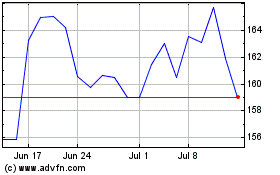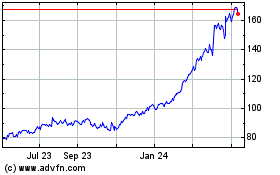Long In Awe of GE, Siemens Emerges From U.S. Rival's Shadow
November 08 2018 - 10:20AM
Dow Jones News
By Ruth Bender
BERLIN -- Siemens AG on Thursday said it would raise its
dividend after solid full-year results in the latest example of how
the German engineering giant, after years of living in the shadow
of rival General Electric Co., is beginning to outshine its U.S.
nemesis.
Siemens, whose management for years used the much larger GE as
their benchmark, has faced many of the same challenges that have
affected the U.S. group -- investor pressure to streamline its
structure, slowing demand in its power business -- yet its latest
figures show it has generally been faster and more successful at
addressing them.
While GE last month slashed its quarterly dividend to a token
penny a share to preserve the little cash it currently generates
for restructuring the company, Siemens said Thursday it would raise
its fiscal-year dividend by 10 euro cents to EUR3.8 a share and
announced a share-buyback program.
Shares of Siemens were up nearly 2% in afternoon trading.
Like other conglomerates, the German group has come under
pressure to streamline its businesses and extract more value from
its vast array of activities under pressure from investors who have
fallen out of love with the once mighty manufacturers of
everything.
But while GE has been grappling with tumbling results and
management crises, Siemens has been reaping the first rewards of
longstanding restructuring efforts in recent years to back further
transformations.
"We have reached a lot with Vision 2020," Siemens Chief
Executive Joe Kaeser told reporters at its annual results press
conference, referring to the group's plan toward better
profitability and reminding of time when Siemens was in a much
weaker spot. "We have a clear plan that we are implementing
consistently and carefully."
Mr. Kaeser has led an effort to refocus the sprawling
conglomerate since he took over as CEO in 2013, shedding
underperforming businesses to focus on a narrower selection of more
profitable units, cutting thousands of jobs and slashing costs
across the board.
In August, Siemens said it would combine its current five
industrial businesses to three -- essentially power turbines and
gas, manufacturing software and automation, and infrastructure.
Under the new structure, to take effect at the end of March 2019,
Siemens units will get more autonomy to make decisions but also
carry more responsibility for meeting financial targets.
Mr. Kaeser also listed the medical technology unit Siemens
Healthineers AG, moved Siemens' wind-power business into a joint
venture with a Spanish rival to form Siemens Gamesa Renewable
Energy SA and is planning to merge its trains activities with
France's Alstom SA.
The CEO, whose term runs until 2021, said the decision to float
Healthineers had been vindicated by a 36% share-price gain since
the new stock started trading.
"This shows that pure plays in today's world have a totally
different significance," Mr. Kaeser said. "Medical technology has
very impressively used the freedom we gave them."
While GE's shares have lost over 50% since the beginning of the
year, Siemens shares have dropped some 11%.
Analysts say Siemens has been taking steps in the right
direction to draw more value out of a company that is still doing
business in a number of areas with little overlap.
But some have criticized the August restructuring announcement
as low on details, for instance about how much it would save by
reducing head-office functions. Others argue Siemens could go
further, for example by merging or selling its troubled power
business, which has been hit by a sharp fall in demand for large
gas turbines.
Jefferies analyst Peter Reilly said Siemens future "remains more
obscure than we would like" after the company Thursday failed to
provide more details on its current internal reorganization.
The short-term cost associated with any large-scale
restructuring was apparent in Siemens's latest quarterly results.
Fourth-quarter net profit nearly halved to EUR681 million ($780.2
million) from EUR1.25 billion a year earlier because of charges
related to job cuts at the power and gas business. Revenue edged up
to EUR22.61 billion from EUR22.22 billion, driven by all businesses
except the power unit.
For the full fiscal year, which for Siemens ends Sept. 30, the
company posted flat net profit of EUR6.12 billion.
In addition to raising its dividend, Siemens said it would
launch a EUR3 billion share-buyback program that will run until
November 2021.
Write to Ruth Bender at Ruth.Bender@wsj.com
(END) Dow Jones Newswires
November 08, 2018 10:05 ET (15:05 GMT)
Copyright (c) 2018 Dow Jones & Company, Inc.
GE Aerospace (NYSE:GE)
Historical Stock Chart
From Mar 2024 to Apr 2024

GE Aerospace (NYSE:GE)
Historical Stock Chart
From Apr 2023 to Apr 2024
